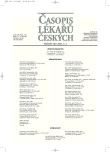-
Medical journals
- Career
Relationships Between the „Eating Inventory“ Factors, Socioeconomic Status, Anthropometric Body Adiposity Indexes and Health Risks in Czech Population
Authors: M. Wagenknecht; V. Hainer; M. Kunešová; F. Bellisle 1; J. Pařízková; R. Braunerová; M. Hill; J. Lajka 2
Authors‘ workplace: Endokrinologický ústav, Praha ; INRA Hotel Dieu, Paříž, Francie 1; Stem/Mark – Centrum sociologických a empirických studií, Praha 2
Published in: Čas. Lék. čes. 2007; 146: 284-291
Category: Original Article
Overview
Background.
The aim of the study was to compare and evaluate psychological traits of eating behaviour assessed using the Eating Inventory (EI) known also as the Three Factor Eating Questionnaire (TFEQ) and their relationship to body adiposity, health and social characteristic in a quota sample of Czech adults.Methods and Results.
The sample included 1624 women and 1429 men who were interviewed individually by instructed investigators. The sample was quota representative – for gender, age, size of residential location, region and socioeconomic status in Czech adults. Anthropometric data were obtained together with socioeconomic and lifestyle information. Subjects filled out the EI. Health status was evaluated according to the data reported by GPs. Our results show, that women had higher restraint but lower disinhibition and hunger scores than men. Hunger and disinhibition were always strongly associated, whereas restraint was negatively related to the other two factors in men, and to hunger in women. In both men and women an educational level positively correlated with dietary restraint and negatively with hunger. However, significant negative relationship between educational level and disinhibition was revealed only in men. In backward stepwise regression analysis both dietary restraint and disinhibition predicted BMI and waist circumference. BMI and waist circumference were negatively related to restraint, but positively to disinhibition. Restraint and disinhibition were associated with prevalence of comorbidities in men, while disinhibition and hunger were in women. Individuals with high scoring in disinhibition score (upper quartile) exhibited significantly higher prevalence of hypertension, cardiovascular diseases and hyperlipidaemia than those who scored low (lower quartile). These relationships were most marked in middle-aged subjects.Conclusions.
Psychological traits of eating behaviour seem to have an important role in the development and clinical expression of body adiposity. Especially disinhibition is significantly associated with BMI and waist circumference and prevalence of several pathologies.Key words:
Eating Inventory, dietary restraint, disinhibition, body mass index, waist circumference, comorbidities.
Labels
Addictology Allergology and clinical immunology Angiology Audiology Clinical biochemistry Dermatology & STDs Paediatric gastroenterology Paediatric surgery Paediatric cardiology Paediatric neurology Paediatric ENT Paediatric psychiatry Paediatric rheumatology Diabetology Pharmacy Vascular surgery Pain management Dental Hygienist
Article was published inJournal of Czech Physicians

-
All articles in this issue
- The Polycystic Ovary Syndrome and Its Male Equivalent
- Polyglandular Activation of Autoimmunity as a Manifestation of Subclinical Endocrinopathies
- Evaluation of Results of Iodine Prophylaxis in Czech Republic
- Diabetes Mellitus in Adult Patients with Type 1 Diabetes Shows Immunological, Functional and Clinical Differences Depending on the Presence of Autoimmune Thyroiditis
- Endocrine Orbitopathy and Significance of Autoantibodies Against 1D Protein
- Influence of Early Postnatal Nutrition in Preterm Infants on Their Anthropometric and Hormonal Characteristics at the Age of 10 Years
- Relationships Between the „Eating Inventory“ Factors, Socioeconomic Status, Anthropometric Body Adiposity Indexes and Health Risks in Czech Population
- Levels of Hormones in Plasma and in Synovial Fluid of Knee Joint of Patients with Rheumatoid Arthritis
- The Institute of Endocrinology Celebrates its 50th Anniversary. How is the Institute Poised for the Next 50 Years?
- Half Century of the Continuation of the Institute of Endocrinology in Prague
- History, Presence and Trends of Steroid Endocrinology
- Study of the Genetic Causes of Polygenetically Determined Endocrinopathies – Patience Can Bring Success
- Growth Hormone Treatment in the Institute of Endocrinology
- The Role of Complement in Autoimmune Thyroid Disorders
- Quality of Life in the Patients with Disorders of Sexual Development and with Y Chromosome in Karyotype
- Polycystic Ovary Syndrome in 2006
- Neurosteroids and Their Function
- Regulatory Network of Transcription Factors: Their Key Role in the Development and Function of Pancreas
- Genetic Background of Mitochondrial Diabetes
- Obesity Based on Mutation of Genes Involved in Energy Balance
- Osteoporosis and Aterosclerosis – is there Any Pathogenetic Association?
- Journal of Czech Physicians
- Journal archive
- Current issue
- Online only
- About the journal
Most read in this issue- Neurosteroids and Their Function
- Relationships Between the „Eating Inventory“ Factors, Socioeconomic Status, Anthropometric Body Adiposity Indexes and Health Risks in Czech Population
- Obesity Based on Mutation of Genes Involved in Energy Balance
- Growth Hormone Treatment in the Institute of Endocrinology
Login#ADS_BOTTOM_SCRIPTS#Forgotten passwordEnter the email address that you registered with. We will send you instructions on how to set a new password.
- Career

